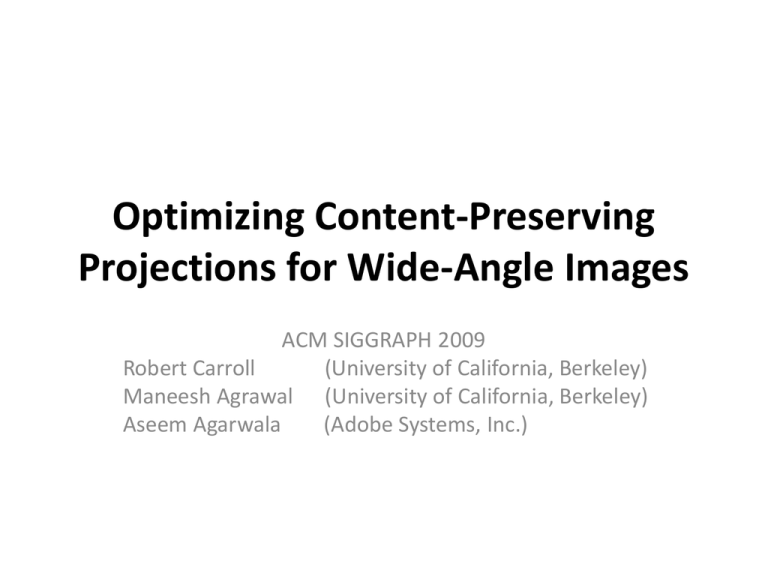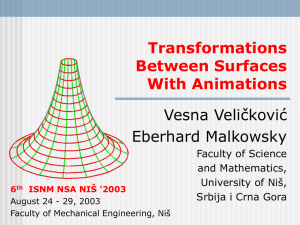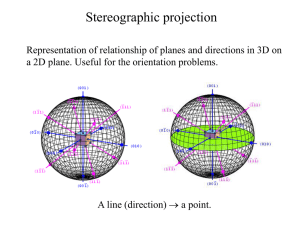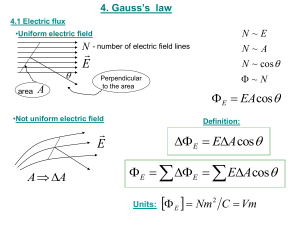Optimizing Content-Preserving Projections for Wide
advertisement

Optimizing Content-Preserving Projections for Wide-Angle Images ACM SIGGRAPH 2009 Robert Carroll (University of California, Berkeley) Maneesh Agrawal (University of California, Berkeley) Aseem Agarwala (Adobe Systems, Inc.) Outline • • • • • Introduction Wide-angle projection Approach Results Future work Introduction Perspective Mercator Stereographic Paper result The space of wide-angle projections • Wide-angle projections should maintain the following properties: – Shape constancy – Orientation constancy • There is no wide-angle projection that can simultaneously preserve all of these properties Perspective projection • The viewing sphere is projected onto a tangent plane through lines emanating from the center of the sphere. – Orientation constancy – Not conformal projection – Robust for fields of view less than about 40° – Field of view approaches 180° the stretching becomes infinite Mercator projection The Mercator projection is a cylindrical projection that is designed to maintain conformality • Conformal projection • It can handle a complete 360 horizontal field of view, but stretches to infinity as the vertical field of view approaches 180. • useful for panoramic images with large horizontal fields of view Stereographic projection The viewing sphere is projected onto a tangent plane through lines emanating from the pole opposite the point of tangency. • Conformal projection • Like perspective projection, stereographic projection stretches objects toward the periphery Approach Load Image Select lines Crop result image Approach Select lines • Click on the two endpoints of the linear structure to specify the constrain – general line constraint endpoints – fixed orientation line constraint (modify the general line constraint) Drawn line Line in the scene endpoints Approach • The general line constraint – Keep linear structures in the scene from bending • The fixed orientation line constraint – Let linear structures map to straight lines at a user-specified orientation in output images (user can choose vertical or horizontal) Approach • Given these line constraints our algorithm computes a mapping from the viewing sphere to the image plane. Mathematical setup • Notations Viewing sphere maps to plane longitude : 𝜆 latitude : 𝜙 𝑣 𝑢 vector form: 𝐮 = 𝑢, 𝑣 𝝀 = 𝜆, 𝜙 Mapping function: 𝑢 𝜆, 𝜙 𝑣 𝜆, 𝜙 , vector form: 𝐮 𝝀 Mathematical setup • Local properties of this mapping 𝐮 𝝀 – Differential vector 𝝀 𝐡= 𝜕𝑢 𝜕𝜙 𝜕𝑣 𝜕𝜙 ,𝐤= 𝜕𝑢 1 𝜕𝜆 𝜕𝑣 cos 𝜙 𝜕𝜆 • Conformal mapping spherical coordinates are non-Euclidean equal steps in 𝜆 travel different distances on the sphere depending on 𝜙 (1) 𝜋 𝜋 cos − sin 2 2 = 𝟎 −𝟏 𝐤 𝐡= 𝜋 𝜋 𝟏 𝟎 sin cos 2 2 (2) 𝜕𝑢 𝜕𝜙 (3) = 𝜕𝑣 1 − 𝜕𝜆 cos 𝜙 , 𝜕𝑣 𝜕𝜙 = 𝜕𝑣 1 𝜕𝜆 cos 𝜙 Cauchy-Riemann equations for mapping a sphere to a plane [Hilbert and Cohn-Vossen 1952; Snyder 1987] Mathematical setup • Discretize the mapping – In our case, we can’t derive a close-form solution – We discretize the mapping by sampling a uniform grid in (𝜆, 𝜙) indexed by integers (𝑖, j) Quad 𝑉: entire set of vertices (𝑖, j) that fall in the field of view of the input image Conformality 𝜕𝑢 𝜕𝜙 =− 𝜕𝑣 1 𝜕𝜆 cos 𝜙 , 𝜕𝑣 𝜕𝜙 = 𝜕𝑣 1 𝜕𝜆 cos 𝜙 (3) • We form conformality constraints on the mesh by discretizing the Cauchy-Riemann equations (3), giving 𝑢𝑖,𝑗+1 − 𝑢𝑖,𝑗 = −(𝑣𝑖+1,𝑗 − 𝑣𝑖,𝑗 )/ cos 𝜙𝑖,𝑗 (4) 𝑣𝑖,𝑗+1 − 𝑣𝑖,𝑗 = −(𝑢𝑖+1,𝑗 − 𝑢𝑖,𝑗 )/ cos 𝜙𝑖,𝑗 (5) Conformality • All quads on the viewing sphere are not equal in size – We weight the constraints by cos 𝜙 𝐸𝑐 = + (𝑖,𝑗)∈𝑉 𝑤𝑖,𝑗 2 ( 𝑣𝑖+1,𝑗 − 𝑣𝑖,𝑗 + cos 𝜙𝑖,𝑗 (𝑢𝑖,𝑗+1 − 𝑢𝑖,𝑗 ))2 (𝑖,𝑗)∈𝑉 (6) 𝑤𝑖,𝑗 2 ( 𝑢𝑖+1,𝑗 − 𝑢𝑖,𝑗 + cos 𝜙𝑖,𝑗 (𝑣𝑖,𝑗+1 − 𝑣𝑖,𝑗 ))2 Straight lines • We define 𝐿: the set of all line constraints marked by user 𝐿𝑓 : orientation line constrain points lie on a line (line is on the viewing sphere) 𝑚𝑎𝑝𝑝𝑖𝑛𝑔 points are collinear on the image plane • Virtual vertex – Midpoint of line-quad intersection – We define a virtual vertex as a bilinear interpolation of the surrounding vertices. Sphere Virtual vertex Straight lines • We compute the position of a virtual vertex on the sphere, and its bilinear interpolation coefficients (a, b, c, d), as shown in Figure 𝑢𝑖+1,𝑗+1 𝑢𝑖+1,𝑗 𝑢𝑖,𝑗+1 𝑢𝑖,𝑗 on which we place our line constraints. Straight lines • : two line endpoints • For the rest of this section we drop the superscript 𝑙 and assume the u variables correspond to virtual vertices for a particular line Straight lines 𝑇 • Distance 𝐮 − 𝐮𝑠𝑡𝑎𝑟𝑡 𝐧(𝐮𝑠𝑡𝑎𝑟𝑡, 𝐮𝑒𝑛𝑑 ) (7) • We therefore define the line energy for a constrained line 𝑙 as (8) This energy function is non-linear, so we simplify the line energy in two ways, each of which can be solved linearly Straight lines • We can express the energy function as another way : Equation (10) is the normalized length of the projection of (𝐮 − 𝐮𝑠𝑡𝑎𝑟𝑡 ) onto (𝐮𝑒𝑛𝑑 − 𝐮𝑠𝑡𝑎𝑟𝑡 ) Straight lines (8) • Two ways to simplify the line energy – By fixing the normal vector in equation (8)、(9) Smoothness (13) (14) Spatially-varying constraint weighting • Line endpoint weights : • Salience weights : • Face detection weights : – face detection algorithm of Viola and Jones [2004], as implemented in OpenCV [Bradski and Kaehler2008] • Total weight Total energy and Optimization • Total energy function 𝐸 = 𝑤𝑐 2 𝐸𝑐 + 𝑤𝑠 2 𝐸𝑠 +𝑤𝑙 2 𝐸𝑙𝑜 + 𝐸𝑙𝑑 (16) • The quadratic energy function at each iteration of our algorithm results in a sparse linear system Ax = 0 • PARDISO sparse direct solver Results Future work • Developing a completely automatic system that identifies salient linear structures using line detection algorithms • Improved by using a more sophisticated salience measure










